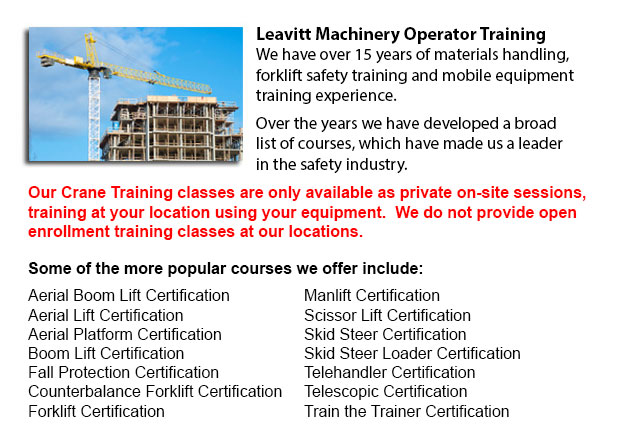
Crane Certification Avondale - The Crane Certification Program consists of the industry suggested subject matter which would teach the efficient and safe operation of cranes. The individual would train in the following: how to identify cranes and their component parts; pre-operational, operational and post-operating requirements; rigging components and inspection/rejection criteria; how to determine overall lift capacity; and requirements particular to the work place where the trainees will be working.
The requirements which need to be done prior to operating a crane like for example assigning authority for the pre-operational check; doing the sequential pre-operational check based on the specifications certified by a professional engineer or manufacturer's specifications; inspecting the work area for obstacles and hazards; checking the log book for comments; inspecting cables, hooks, chains crane movement and safety latches; ensuring the correct functioning of operational controls; and knowing how to make sure that the crane's disconnect switch/isolator is functioning correctly.
The requirements to operating a crane would comprise the identifying of responsibilities and roles, and the determination of the requirement for a formal lift plan. The individual training would be taught how to do danger assessments for the different environmental circumstances, physical situations and staff. Subject matter consists of determining when to seek competent assistance, the destination of loads and the safest route, and load weight and centre of gravity.
People training should be able to identify an over-capacity lift, in addition to be able to select appropriate rigging machinery, choose load limits, and to determine the safe location for the crane to work from. Trainees will review both site-specific and universal crane signals for lifts, and methods for lifting, loading and traveling. Correct maintenance habits will be covered.
Trainees would be evaluated on their understanding of the need for emergency response procedures for different situations like for instance an electrical or mechanical failure. They would be asked to describe shut down and parking procedures for security and safety, to follow tagging and lock out procedures, and to explain why near misses are recorded and reported to the appropriate person. Log book records must be maintained.
Individuals training would develop knowledge of rigging, in particular, establishing who has authority and responsibility for rigging, identifying various types of rigging, knowing load capacity ratings and storage procedures.
The requirements following operation of the crane will be taught also, learning to enter the defects and deficiencies; and to log the history of maintenance and service records, based on the state, provincial and federal codes requirements.
Site-specific needs could be included into the safety training program according to the employer's needs.
-
Forklift Certification Courses Avondale
Forklift Certification Courses Avondale - Forklift certification courses really help to be able to make sure that companies using forklifts, follow the local and regional rules. The drivers of the forklift need to go through forklift certification pr... More -
Manlift Certification Avondale
Manlift Certification Avondale - The Elevated Platforms and Manlifts Certification course helps to provide the required training on the work practices, safe operating procedures, rules and regulations regarding the daily activities for the operators... More -
Manlift Operator Training Avondale
Manlift Operator Training Avondale - The aerial lift or manlift is a specialized type of hydraulic platform that is intended to hoist a person vertically giving it an alternate name of a vertical personnel lift. These machinery are widely used for a... More -
Telescopic Training Avondale
Telescopic Training Avondale - Telescopic Handlers are a type of forklift, normally called telehandlers. This machine has been increasing in popularity because of its greater lift heights and its versatility. It is often preferred over the convention... More -
Heavy Equipment Training Avondale
Heavy Equipment Training Avondale - The two most common types of heavy equipment training are classed into the categories of equipment; equipment that is fashioned with rubber tires or those with tracks. The tracked vehicle are heavy duty equipment l... More -
Aerial Lift Train the Trainer Avondale
Aerial Lift Train the Trainer Avondale - The Aerial Lifts Train the Trainer Certification Program would teach trainers how to efficiently train operators in safe industrial mobile equipment operation. Trainers are provided with in-depth instruction a... More -
Overhead Crane Safety Training Avondale
Overhead Crane Safety Training Avondale - The overhead crane safety training program is meant to equip the operators with the right knowledge and skills in the areas of: crane safety measures, accident avoidance, materials handling, and stock and equ... More -
Heavy Equipment Training Schools Avondale
Heavy Equipment Training Schools Avondale - When choosing an operator training course, there are numerous heavy equipment training schools to select from. In order to ascertain the qualifications you would attain, it is very important to check some a... More

Forklift Training Avondale
TOLL FREE: 1-888-254-6157
Avondale, Arizona
forkliftcertificationavondale.com
Email Us
About Us


